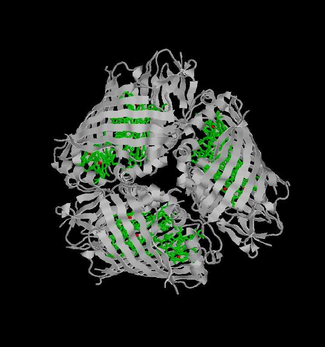
Fenna-Matthews-Olson complex
Encyclopedia

Pigment
A pigment is a material that changes the color of reflected or transmitted light as the result of wavelength-selective absorption. This physical process differs from fluorescence, phosphorescence, and other forms of luminescence, in which a material emits light.Many materials selectively absorb...
-protein
Protein
Proteins are biochemical compounds consisting of one or more polypeptides typically folded into a globular or fibrous form, facilitating a biological function. A polypeptide is a single linear polymer chain of amino acids bonded together by peptide bonds between the carboxyl and amino groups of...
complex (PPC) that has been structure analyzed by x-ray spectroscopy. It appears in green sulfur bacteria
Green sulfur bacteria
The green sulfur bacteria are a family of obligately anaerobic photoautotrophic bacteria. Most closely related to the distant Bacteroidetes, they are accordingly assigned their own phylum....
and mediates the excitation energy transfer from the light-harvesting chlorosome
Chlorosome
A Chlorosome is a photosynthetic antenna complex found in green sulfur bacteria and some green filamentous anoxygenic phototrophs . They differ from other antenna complexes by their large size and lack of protein matrix supporting the photosynthetic pigments...
s to the membrane embedded bacterial reaction center (bRC). The structure of the FMO complex is trimeric (C3-symmetry) and each of the three monomers contains eight bacteriochlorophyll
Bacteriochlorophyll
Bacteriochlorophylls are photosynthetic pigments that occur in various phototrophic bacteria. They were discovered by Von Neil in 1932 . They are related to chlorophylls, which are the primary pigments in plants, algae, and cyanobacteria. Groups that contain bacteriochlorophyll conduct...
a (BChl a) molecules, which are bound to the protein scaffold via ligation of their central magnesium atom either to amino acids of the protein (mostly histidine
Histidine
Histidine Histidine, an essential amino acid, has a positively charged imidazole functional group. It is one of the 22 proteinogenic amino acids. Its codons are CAU and CAC. Histidine was first isolated by German physician Albrecht Kossel in 1896. Histidine is an essential amino acid in humans...
) or water-bridged oxygen atoms (only one BChl a of each monomer).
Since the structure of the FMO complex is available, one can try to calculate structure based optical spectra in comparison with experimental optical spectra. In the simplest case only the exciton
Exciton
An exciton is a bound state of an electron and hole which are attracted to each other by the electrostatic Coulomb force. It is an electrically neutral quasiparticle that exists in insulators, semiconductors and some liquids...
ic coupling of the BChls is taken into account, while more realistic theories also consider the pigment-protein coupling. A very important property is the local transition energy (site energy) of the BChls, which is different for each of them, due to their individual local protein invironment. The site energies of the BChls determine the direction of the energy flow.
There is some structural information on the FMO-RC super complex available, which has been obtained by electron microscopy and linear dichroism
Dichroism
Dichroism has two related but distinct meanings in optics. A dichroic material is either one which causes visible light to be split up into distinct beams of different wavelengths , or one in which light rays having different polarizations are absorbed by different amounts.The original meaning of...
spectra measured on FMO trimers and FMO-RC complexes. From these measurements, two possible orientations of the FMO complex relative to the RC are possible. Recently it was possible to decide which of the one orientations is useful for efficient energy transfer, namely the orientation with BChl 3 and 4 close to the RC and BChl 1 and 6 (numbering according to the original numbering of Fenna and Matthews) oriented towards the chlorosomes.
The FMO complex remains an interesting object for studies, because it is the simplest PPC appearing in nature and therefore a suitable test object for the development of methods, that can be transferred on more complex systems like photosystem
Photosystem
Photosystems are functional and structural units of protein complexes involved in photosynthesis that together carry out the primary photochemistry of photosynthesis: the absorption of light and the transfer of energy and electrons...
I.

